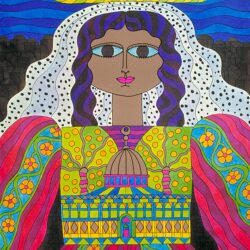MoMu restores: 18th-century French dress

The piece is quite fragile and both the accompanying petticoat and compère (the false front) were missing. As it is a rather precious object, a replica was made of the missing parts in a fabric that included an imitation of the brocade work on the original. After all, these parts were usually in the same fabric as the dress itself. Thanks to modern-day techniques, these historical materials can be reproduced more easily.

In collaboration with the New York company, Dyenamix, the original silk was reproduced with a digital print on a silk of the same kind. The first step was to make a digital version of the pattern. Producing different test prints made it possible to match the original colour and print as closely as possible. From a distance, the printed version and the authentic brocaded flower motif are almost indistinguishable from each other. Since a replica is an encroachment on the original, it must always be possible for ethical reasons to see a certain difference between the two. After that, the compère, petticoat, matching crinoline and underskirt were reproduced based on costume historical research. The petticoat and compère were finished with ruches like on the dress.
The condition of the dress itself was moderate and it was in need of conservation treatment. The piece was presumably once used in the theatre and had been altered for that purpose. Those minimal alterations would now be reversed. The dress had been let out at some point in the past. As a result, the typical Watteau pleat on the back was no longer correct. The letting out itself was limited to opening up the seams. The original sewing stitches were still visible. This meant that the folds could be fixed in place in the original way. The folds were smoothed out with cold ultrasonic steam and glass plates. The front side seams of the body had also been widened. The presence of the original sewing stitches meant that this widening could be reversed. In this way the dress was returned to its original form.

The silk was extremely fragile and there were tears in the sleeves and bodice. These were preserved by placing a silk pongee fabric, painted in the same colour as the original, under the gaps to reinforce them. These gaps are supported on the reinforcing fabric by means of tension stitches with silk thread. Open seams were closed. The strips of lace on the sleeves were torn and very dirty. They were removed from the dress and cleaned so that the full effect of the original golden colour can be seen once again. The tears and gaps were preserved between two layers of conservation tulle and painted in the same colour as the lace, making them virtually invisible. The dress was given a custom made bust with matching undergarments to support the piece as a whole. The dress can now be admired again in all its glory.


